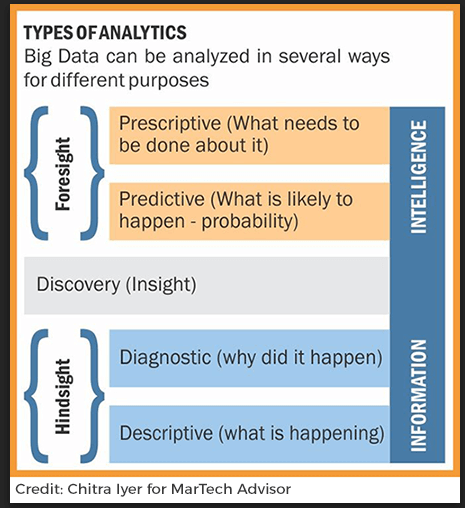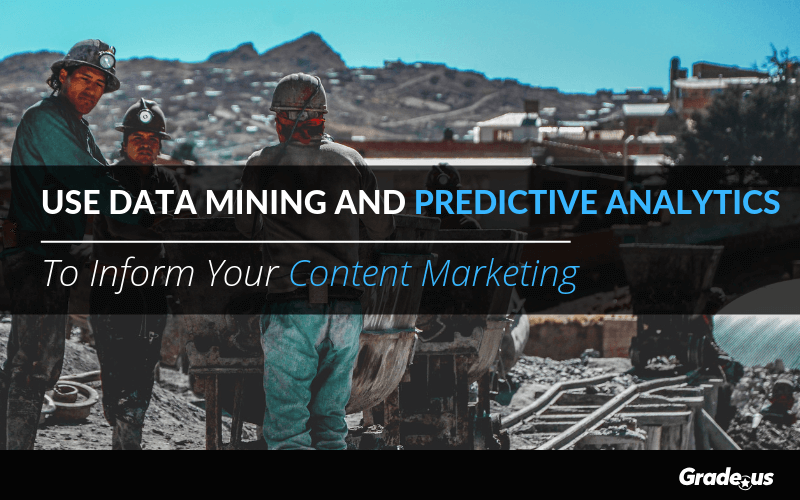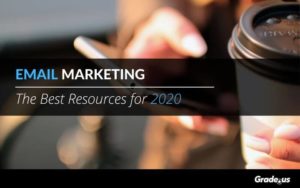Everybody talks about analytics.
Everyone's tracking some: traffic, click through rates, bounce rates, rankings, form completions, site searches.
In the digital marketing world, just about everyone uses data to make some sort of adjustment, like changing headlines, tweaking landing pages, or using different keywords in their copy.
Everyone talks about "big data," too. Data and analytics have some incredible potential. Unfortunately, it's so misunderstood that the potential often goes untapped.

People don't have much trouble understanding how data can help them see what has and hasn't happened in the past. Which is why most data use is diagnostic and descriptive, not prescriptive or predictive.
But data also has the power to tell you a great deal about what can happen in the future.
Specifically, it can show you correlations between actions you probably didn't think about and actions you want or don't want to happen.
For example, it can help outside sales teams waste a lot less time by using certain factors to identify which prospects are most likely to buy. It can predict increases in retail sales by showing you which products need to be shelved close to one another. It's been used in a variety of different ways to reduce crime, such as identifying times and places where crime is more likely to occur so that police patrols could be deployed in those areas.
And when Kansas City discovered there was a correlation between having access to fast internet service and student reading scores, they became one of the first to adopt Google Fiber. Student performance improved...at least, it did while even the most basic level of Google Fiber remained free.
Predictive analytics offers the power that comes from looking at a bunch of information and going, "Ah. If we do this, and maybe also this, we can get that."
Thus, it can also tell you a lot about, say, the types of content you post, who you aim it at, and the number of shares you receive. Or the number of email sign-ups it gets. Or the amount of traffic it pulls in. You can then use those insights to solve a fundamental business problem: what kind of content should I concentrate on producing?
What does the marriage between content marketing and predictive analytics look like?
Syed Irfran Ajmal, Growth Marketing Manager at Gigworker, uses predictive analytics while planning and producing his content. He's been running some tests, starting with the Finance subcategory of content on the Gigworker website.
"We look at dwell time, bounce rate, and visitors," Ajmal says. "We then choose to create pieces similar to the ones which were popular. We're able to predict their future likes, dislikes, and decisions, and come up with action plans that can influence their future choices."
He says marketers might point out he could have simply reviewed the keywords which have large search volumes on any number of keyword research tools, and he acknowledges they wouldn't be entirely wrong.
"But the behavioral data of our site visitors is more important for us than what is popular for an entire city or country. What we see in Google Keyword Planner might not hold true for our visitors. We've been able to accurately predict how the visitors will respond to an upcoming content piece, and that's been extremely helpful."
That means saving time and money by creating content that works — and only content that works.
The Martech Advisor reports that predictive content analytics generates more page views with 77% less content created.
"Our work cuts digital acquisition costs by 20% to 60%," says Karrie Sullivan, Principal of the Culminate Strategy Group. Her company is devoted to using data science and automation to drive organizational change for client companies.
Both these number sets are, of course, talking about producing less content as if that's a good thing to do, instead of simply using it as a way to demonstrate just how effective the content is.
But the way freshness, sharing, and the ephemeral nature of social views work tells me that you don't necessarily want to cut down on content production. The site with the best content always wins, and having more content rarely hurts.
Unless, of course, it's completely outdated and trashing your site structure. See How to Approach SEO and PR for Different Industries as a Consultant, with Rob Woods, for a discussion of when this happens, how it happens, and what to do about it.
But if you're using predictive analytics to make sure every piece of content you create is capable of delivering, and you are producing content on the regular, you have the power to step beyond winning. You can move straight to "leaving your competition in your dust."
Don't believe me? Convince and Convert offered an example case which showed it might take as many as 120 pieces of content just to answer customer questions. That doesn't even address content which helps keep customers informed, give them advice, or solve their problems...the stuff that tends to help you get visible at all by getting you links and shares.
Convince and Convert uses predictive analytics, too.
The goal isn't necessarily to trim content. It's to get the most value out of the content you're creating, period.
Now, all you have to do is figure out how to do it.
"We use a combination of design thinking, data science, and agile marketing to do this, including deep social content, sentiment, and behavior data," Sullivan notes.
She notes the data processing feeds the entire content brainstorming process her company performs for clients.
"We define and refine customer segmentation and clustering, then drive high levels of content relevancy and efficiency in content production. Data guides our ideation, prioritization, and experimentation."
If it sounds like this is complicated, it's because it is — data scientist is its own job title for a reason.
Fortunately, you don't have to become a data scientist to start applying analytics to your content marketing.
Predictive MarTech Solutions.
If you're anything like me, you need user-friendly solutions which are easy to set up and use.
I've been interested in predictive analytics for a long time, even though I'm relentlessly right-brained. And this whole article grew out of me asking myself the following question:
I wonder if anybody is using predictive analytics to help them produce great content, and how that's working out for them?
Since the answers were: "yes," and "great," I went looking for a platform that I thought might work out well for me and folks who think like me. Here are a couple of the options I found.
First, Marketo.
It clearly explains that it does everything I'd need and want it to do, which already puts it ahead of the first three or four options I looked at. It looks perfect, but it's expensive.
The Marketing Automation Insider reports even their most modest package costs nearly $900 a month. They wanted folks to call for pricing, probably because they thought some people might balk at the price if there wasn't a live human on the other end of the phone to talk them through it.
I am definitely balking at that price. But for the moment I'm an independent consultant. An agency might find the pricing more than reasonable, especially given the potential returns.
How about free? I like free.
It turns out a free tools do exist. For one thing, Google Analytics can apparently do a lot more than I've been using it for.
But I got excited by LinkedIn Website Demographics. It looks positively ideal for B2B sellers, since it uses LinkedIn data to note what types of people are visiting your site, tracking job titles and fields.
You can then discover what content is resonating with that audience. That's diagnostic and descriptive again, so you'll need to take the additional steps the manual way, which is trying to predict what future types of content will do well.
But the way forward here seems simple enough. Pull the top 10 performers, try to isolate what they have in common, jot down the factors, and then start creating new content that contains one, and only one, element common to the success set. See what happens.
Results aren't conclusive? You might need to take another step: creating content that, say, contains two of the success elements to see if it's actually a set of elements in combination that work well. Or if a piece requires all the common elements to succeed.
It's detective work, but as I understand it, most predictive analytics projects involve a little detective work. And it's a problem even a gal who consistently got Ds in math can solve.
Besides generating buyer personas is a heck of a lot easier when you've got a whole bunch of real-world buyer personas right there in front of you.
Everything in between?
There is, of course, a great chance you made As in math, and do not, in fact, think like me. So here's a list that contains 18 additional options and an entire list of agency tools and local marketing agency tools to review.
There's a little bit of a scientist in all of us.
If you believe, as Andy Crestodina does, that everything you choose to do on a website is basically a hypothesis, then using your existing experiments to predict which experiments are going to go even better is a time-saver that makes sense.
There are pitfalls. Choosing complex tools, for example, increases the likelihood that you're going to create a process that spits out erroneous results. And it's possible to get so lost in the data that you don't know up from down anymore, mucking about, measuring, and running tests that don't help you solve content problems. Or any other type of business problem.
But on the whole? I think it's safe to predict applying at least a little bit of predictive analytics to your content marketing is a worthwhile endeavor.
Have you used predictive analytics to inform your marketing? How did you do it? What were the results? Did this right-brained babe miss something important, or even say something goofy? Share your knowledge in the comments below, because I, for one, would love to know.
About the Author
Raney C. Hudson
Raney C. Hudson is an independent content consultant with a 10+ year track record in the digital marketing industry.











